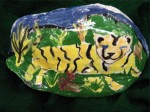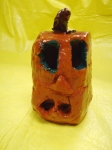In the late fall I began my 6th grade unit on ‘Day of the Dead’, introducing my students to the #1 Mexican celebration, observed Nov 1st and Nov 2nd coinciding with All Saints Day and All Souls Day. It is a combination of both a Christian celebration, beginning when the Spaniards came to Mexico over 500 years spreading Christianity and the pagan celebration dating back to the Aztecs. Of course over time both celebration changed and now ‘Dia de los Muertos’ has become an integral part of the Mexican culture. My students viewed a film on Mexico and we had some great discussions. They then began designing their own mask for this celebration, with three basic rules: one it had to be ‘skull’ like, two it had to represent something about them and three, it had to contain the marigold, the flower symbol of death. Connecting the learning back to them is a key concept today for literacy! The new slab roller was perfect for this lesson, rolling out large flat even pieces of clay. Using simple modeling tools, small damp sponges, the students blew me away with their approaches and designs. After a bisque firing the students use underglazes to paint on their colors and draw on some images, eventually covering the entire mask with a clear overglaze. They used wire to hang their mask, some using yarn to cover the wire.
Lastly was the writing componenet to this unit. Since it had been weeks since we began this unit students were given handouts filled with facts on the celebration. They were to write a poem, their choice, reflecting both some of the history of the celebration and how they connected to the mask. As always, an amazing learning experience for all!
Since many of my students have traveled to Mexico, on cruise ships or staying at the fancy resorts, they now knew some interesting facts about the Mexican people by exploring one aspect of their rich culture.


































